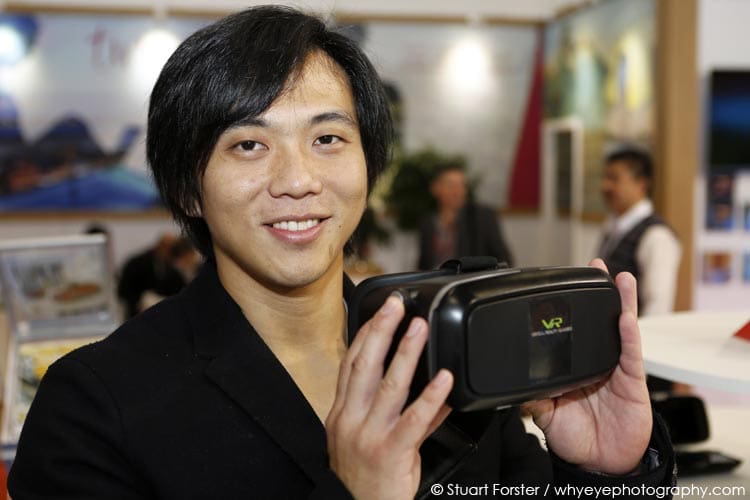At the 2015 World Travel Market, held at the ExCeL London, I pulled on a headset and took a look at the future of tourism. Virtual Reality – or VR as it’s known to insiders – seems set to become the next big thing in the travel industry.
At one of the hundreds of stands in the vast halls of the ExCeL London, I pulled a padded, black plastic headset emblazoned with the words Virtual Reality. Roughly the same size and shape as a scuba diving mask, the headset proved surprisingly comfortable.
Ivan Chen of Anantarupa Studios
Ivan Chen – the Chief Executive Officer of Anantarupa Studios, a Jakarta-based digital content developer – stood by me as I wore the headset. It gave me a 3-D, aerial view of a sun-kissed island landscape.
He encouraged me to move my head and look around. As I did so the view changed, just as it would if I was looking around in real life.
3D views of the world
The 3D footage did a great job of conveying the illusion that I was floating through the sky. Then I descended towards the sea, splashing through its surface to view shoals of colourful fish and graceful rays. When I looked up I was able to see the sun shimmering above through several metres of virtual water.
Impressed by the experience, I asked Ivan for more information about his company and what they were doing at the World Travel Market.
“My company develops games and apps. Recently we’ve developed for Virtual Reality. We develop Virtual Reality products,” he answered.
Virtual Reality and Augmented Reality
“Virtual Reality is different to Augmented Reality. Augmented Reality brings digital objects to our real world. Where Virtual Reality brings us into a virtual world,” he explained.
I was keen to understand what I’d just experienced. Obligingly, Ivan opened the headset to reveal a standard-looking Samsung device housed within.
“Technically this is just a gadget to show the content that we develop. We can use any kind of device. We have cardboard and plastic ones with a smartphone. This is just a media,” he said.
I later learnt that cardboard headsets are available on Amazon for as little as $18.
Experiencing a destination’s ambience and environment
“We shoot with a special camera. With the film we ask the audience to come with us to a country and experience the ambiance and the environment, as if you are there – that’s the idea,” responded Ivan when I asked him how the technology is being used at present.
For people within the travel industry Virtual Reality appears to have enormous potential. In addition to reading about destinations in books, blogs and brochures people now have opportunities to take a look around the places to which they are considering travelling.
“They can have a sneak peak of the place. They can say this is the kind of environment I want to go to for my vacation. This is one way to promote tourism using technology,” said Ivan.
Booking tickets and hotels
“There’s a lot of interest. We are working on a platform to connect our marketing tools and the marketplace, so people can search hotels and book tickets from our application,” he added.
Let’s see how long it takes before travel agencies have Virtual Reality headsets to showcase resorts, key destinations and iconic landmarks. Maybe we’ll all be watching films on VR headsets a few years from now?
Maybe it’s my imagination but didn’t the Tomorrow’s World television programme suggest we’d all have robots to undertake our household cleaning chores by the year 2000? I’m still waiting. Hopefully the roll-out of Virtual Reality technology will be markedly quicker.
Further information
Photos illustrating this post are by Stuart Forster.
If you enjoyed this post why not sign up for the free Go Eat Do newsletter? It’s a hassle-free way of getting links to posts on a monthly basis.
‘Like’ the Go Eat Do Facebook page to see more photos and content.



